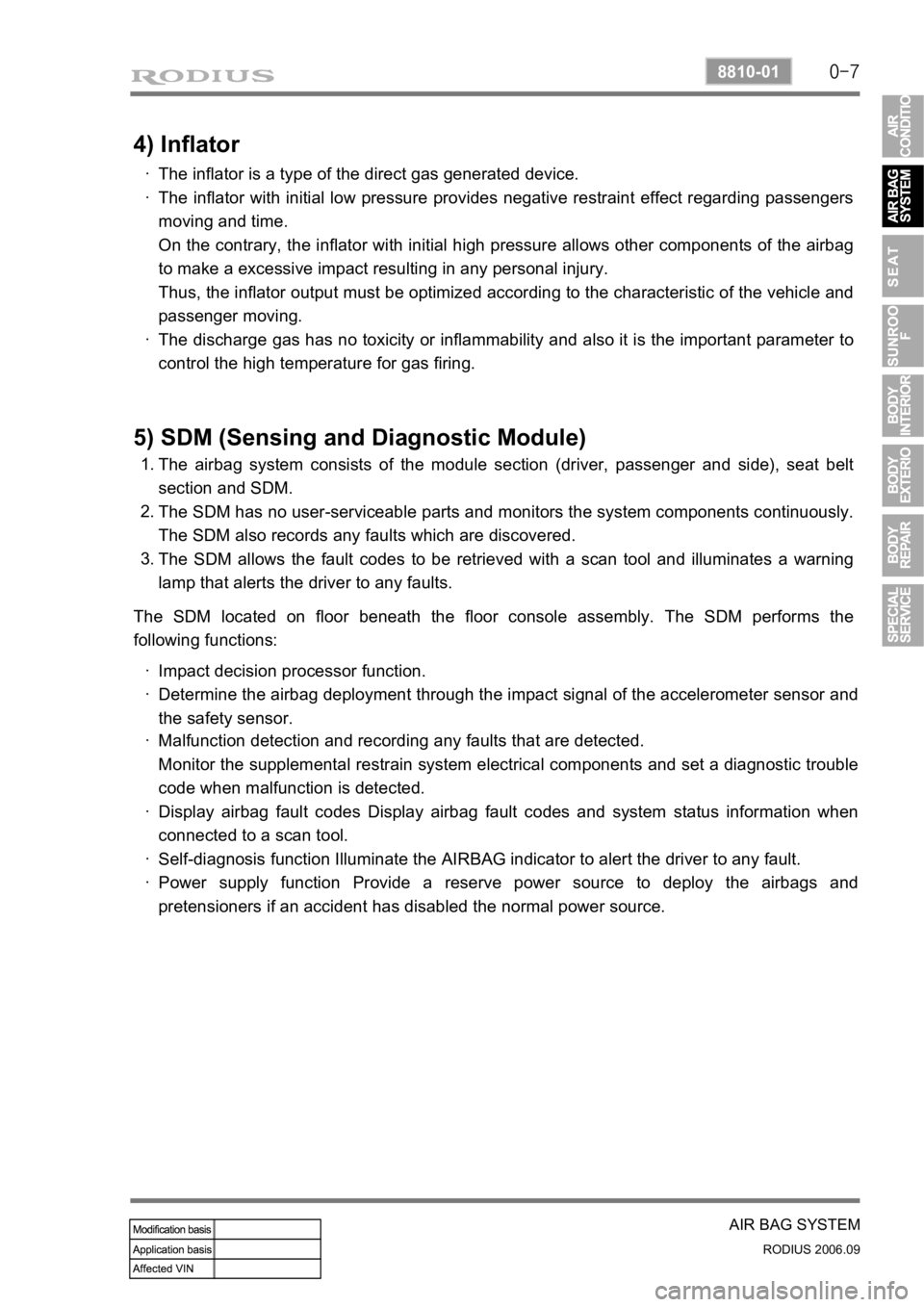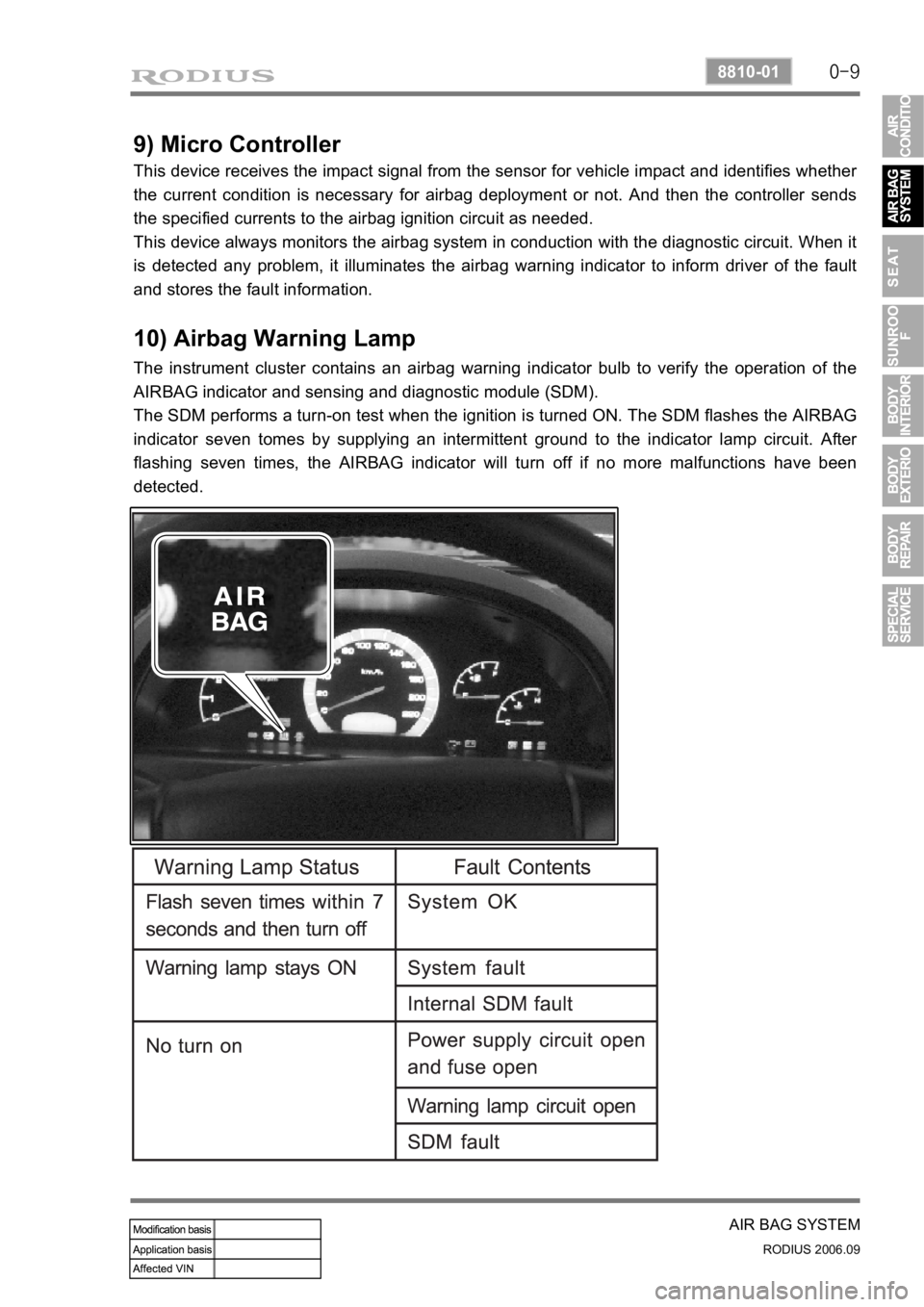2007 SSANGYONG RODIUS sensor
[x] Cancel search: sensorPage 389 of 465

0-17
AIR CONDITIONING SYSTEM
RODIUS 2006.09
6810-20
5. AIR QUALITY SYSTEM (AQS)
1) Components of AQS
Air Quality System (AQS) changes the air source selection to recirculation mode when polluted
air is detected through AQS sensor. The air source selection returns back to fresh air intake
mode after a specified period or the polluted air is disappeared.
AQS sensor and ambient temperature sensor
AQS sensor
Ambient
temperature
sensor
Connector
AQS and air source selection switch
The AQS switch is integrated with the air source selection switch.
AUTO Mode
The air source is not changed when pressing the AQS and air
source selection switch in “AUTO” mode. However, the
indicator on the switch turned ON/OFF. In other words, the air
source cannot be changed to recirculation mode in AUTO mode
by just pressing the switch. To change the air source to
recirculation mode in AUTO mode, get into Manual mode first,
then press the air source selection switch.
Manual Mode
To change the AQS mode to Manual mode from AUTO mode,
use the MODE switch or the fan speed control dial. In Manual
mode, the “AUTO” symbol on the display is disappeared.
When pressing the AQS and air source selection switch, the
mode is changed in order of AQS LED ON, AQS LED OFF
(fresh air), and air source LED ON (recirculation).
The figure shows that the mode has been changed to the
recirculation mode from fresh air mode under AQS mode (AQS
LED ON) after detecting the polluted outside air.
Page 390 of 465

0-18
RODIUS 2006.09
6810-20
AIR CONDITIONING SYSTEM
2) AQS Operation
The AQS operates under air conditioner AUTO mode or when the AQS switch is pressed under
manual mode. It requires preheating time (for seconds) for operation and the module and
sensor are integrated. (However, it operates only when the DEF (defroster) switch on the ai
r
conditioner switch panel is not pressed in.)
Self diagnosis and preheating process during initial operation of A/C controller
(AUTO mode)
1.
AQS operation (AQS switch is pressed in): detecting the polluted outside air
2.
When the air conditioner controller is operated
in AUTO mode during its initial operation, the
air source is changed to the recirculation
mode and AQS LED comes on.
(This is the self diagnosis and preheating
process for AQS.)
1.
After completing the above process, the
AQS
LED is turned off and the air source is
automatically changed to the fresh air mode.
2.
If the AQS switch is pressed in, the AQS
function works regardless of air conditioner
controller operation.
When pressing the AQS switch, the LED on
the AQS switch is turned on and the
AQS
function is activated.
When the polluted outside air is detected, the
AQS operates and converts the air source to
recirculation mode automatically. At this
moment, the recirculation mode indicato
r
comes on in the display.
1.
2.
Page 392 of 465
![SSANGYONG RODIUS 2007 Service Manual 0-20
RODIUS 2006.09
6810-20
AIR CONDITIONING SYSTEM
3) AQS Operation Circuit
1. Ambient temperature switch
2. Sensor ground
3. AQS signal (Output)
4. Ground
5. IGN 2
[AQS sensor] ▶
Measure the volt SSANGYONG RODIUS 2007 Service Manual 0-20
RODIUS 2006.09
6810-20
AIR CONDITIONING SYSTEM
3) AQS Operation Circuit
1. Ambient temperature switch
2. Sensor ground
3. AQS signal (Output)
4. Ground
5. IGN 2
[AQS sensor] ▶
Measure the volt](/manual-img/67/57524/w960_57524-391.png)
0-20
RODIUS 2006.09
6810-20
AIR CONDITIONING SYSTEM
3) AQS Operation Circuit
1. Ambient temperature switch
2. Sensor ground
3. AQS signal (Output)
4. Ground
5. IGN 2
[AQS sensor] ▶
Measure the voltage value of AQS. (between connector terminal No. 3 and 4.)
If the measured voltage is out of 0.1 to 4.8 V, replace the AQS.
If the measured voltage is out of the specified range, replace the AQS. If it is within the
specified range, check as below.
Turn the ignition key to “ON” position.
Measure the voltage between terminal B9 and B15 on the air conditioner controller.
If the voltage value cannot be measured, check the circuit for open. If the measured value is
within the specified range, replace the FATC controller. 1.
2.
3.
4.
5.
6.
Remove the sensor and measure the resistance between terminal No. 5 and 6 on the senso
r
connector. (standard: approx. 25°C, 2.2 kΩ) In addition, if the resistance is extremely
high or low, replace the sensor.
If the measured value is out of the specified range, replace the ambient temperature sensor.
If the measured value is within the specified range, check as below.
Turn the ignition switch to ON position and measure the voltage to ambient temperature
sensor from the FATC controller connector. (standard: approx. 2 V at 25°C)
If the voltage value cannot be measured, check the circuit for open. If the measured value is
within the specified range, replace the FATC controller. 1.
2.
3.
4.[Ambient temperature sensor] ▶
Page 393 of 465

0-21
AIR CONDITIONING SYSTEM
RODIUS 2006.09
6810-20
6. AIR CONDITIONER MODULE SENSORS AND ACTUATORS
1) Duct Temperature Sensor
The duct temperature sensor is installed on the top of heater unit. It detects the inside
temperature of duct and transmits the voltage value that is changed according to resistance
value (NTC) to FATC controller.
(1) Inspection
If the duct temperature sensor defect code (DTC 3) is set, check as below.
▶
Remove the duct temperature sensor and measure the resistance between terminals on the
sensor connector. (standard: approx. 25°C, 2.2 kΩ) In addition, if the resistance is
extremely high or, replace the sensor.
If the measured value is out of the specified range, replace the duct temperature sensor. I
f
the measured value is within the specified range, check as below.
Turn the ignition switch to ON position and measure the voltage to duct temperature senso
r
from the FATC controller connector.
(standard: approx. 2 V at 25°C)
If the voltage value cannot be measured, check the circuit for open. If the measured value is
within the specified range, replace the FATC controller.
1.
2.
3.
4.
Page 407 of 465

0-7
AIR BAG SYSTEM
RODIUS 2006.09
8810-01
4) Inflator
The inflator is a type of the direct gas generated device.
The inflator with initial low pressure provides negative restraint effect regarding passengers
moving and time.
On the contrary, the inflator with initial high pressure allows other components of the airbag
to make a excessive impact resulting in any personal injury.
Thus, the inflator output must be optimized according to the characteristic of the vehicle and
passenger moving.
The discharge gas has no toxicity or inflammability and also it is the important parameter to
control the high temperature for gas firing. ·
·
·
5) SDM (Sensing and Diagnostic Module)
The airbag system consists of the module section (driver, passenger and side), seat belt
section and SDM.
The SDM has no user-serviceable parts and monitors the system components continuously.
The SDM also records any faults which are discovered.
The SDM allows the fault codes to be retrieved with a scan tool and illuminates a warning
lamp that alerts the driver to any faults. 1.
2.
3.
The SDM located on floor beneath the floor console assembly. The SDM performs the
following functions:
Impact decision processor function.
Determine the airbag deployment through the impact signal of the accelerometer sensor and
the safety sensor. ·
·
Malfunction detection and recording any faults that are detected.
Monitor the supplemental restrain system electrical components and set a diagnostic trouble
code when malfunction is detected.
Display airbag fault codes Display airbag fault codes and system status information when
connected to a scan tool.
Self-diagnosis function Illuminate the AIRBAG indicator to alert the driver to any fault.
Power supply function Provide a reserve power source to deploy the airbags and
pretensioners if an accident has disabled the normal power source. ·
·
·
·
Page 408 of 465

0-8
RODIUS 2006.09
8810-01
AIR BAG SYSTEM
6) Contact Coil
The contact coil is installed between the steering wheel and the steering column and contains a
coil that enables to contact electrically between the airbag wiring harness, the driver airbag
module and the horn switch.
Turning the steering wheel more than three and onequarter turns may damage the clock
spring. The contact coil should never be disassembled and must be replaced if the airbag
have been deployed. -
Turn the label of the clock spring clockwise to lock and turn the label of the clock spring
counterclockwise approximately 2.9 ± 0.2 turns to the neutral positions with the front
wheels ahead.
Align the pointed marks “43”. -
7) Accelometer Sensor
The accelerometer sensor electronically represents the acceleration or deceleration of the
vehicle during a frontal impact.
In this electronic representation, the electrical signal is proportional to the acceleration o
r
deceleration of the vehicle.
8) Safety Sensor
The safety sensor is safety device made up of a dualcontact, electro-mechanical switch that:
Acts independently of the electronic components.
Connects the acceleration sensor in series in order to make up for the weak points in the
current electronic sensor. 1.
2.
Page 409 of 465

0-9
AIR BAG SYSTEM
RODIUS 2006.09
8810-01
9) Micro Controller
This device receives the impact signal from the sensor for vehicle impact and identifies whether
the current condition is necessary for airbag deployment or not. And then the controller sends
the specified currents to the airbag ignition circuit as needed.
This device always monitors the airbag system in conduction with the diagnostic circuit. When it
is detected any problem, it illuminates the airbag warning indicator to inform driver of the fault
and stores the fault information.
10) Airbag Warning Lamp
The instrument cluster contains an airbag warning indicator bulb to verify the operation of the
AIRBAG indicator and sensing and diagnostic module (SDM).
The SDM performs a turn-on test when the ignition is turned ON. The SDM flashes the
AIRBAG
indicator seven tomes by supplying an intermittent ground to the indicator lamp circuit.
After
flashing seven times, the AIRBAG indicator will turn off if no more malfunctions have been
detected.
Page 411 of 465

0-11
AIR BAG SYSTEM
RODIUS 2006.09
8810-01
4. INFLATION OF AIRBAG
<0d960047006d009900960095009b004700680090009900890088008e004700760097008c00990088009b0090009600950047004f006b00990090009d008c009902c5009a004700880095008b004700770088009a009a008c0095008e008c009902c5009a00
50>
The air bag inflates when:
Frontal impact against a solid concrete wall at over 25 km/h or near-frontal impact
within 30 degrees from the center of the vehicle at both corners ·
The air bag can inflate when:
Underbody impact from the road surface; impact against the curb at a very high speed;
dropping impact onto the road surface with a large angle ·
The air bag does not inflate when:
Rollover, side impact or rear impact ·
The air bag seldom inflates when:
Weak impact in which the sensor is unable to detect (under the inflation requirements)
Impact against narrow objects such as a telegraph pole or a tree
The vehicle falls into a drainage or a puddle
The front of the vehicle crashes into high impact point vehicle such as a truck
Impact on the hood by falling stones
The air bag warning lamp is on ·
·
·
·
·
·